St John the Evangelist
Levens, Cumbria
A local landmark, the church is set on the end of a limestone ridge at the gateway to the Lake District National Park with beautiful views across the Kent Estuary to Morecambe Bay.

Built in 1726, the church commands extensive views across the Lyth valley towards the distant Lakeland fells and Morecambe Bay.
Helsington, Cumbria
The interior is beautifully simple but an outstanding feature is the war memorial mural, painted in 1919. In the silence you will find St John’s a spiritual place in which to reflect and pray. The churchyard is a tranquil place to sit awhile, in spring a carpet of snowdrops, then daffodils and later wild flowers.
From Norman times the population of Helsington, one of 24 townships in the greater parish of Kendal, worshipped at Kendal parish church. Then in 1726 John Jackson of nearby Holeslack Farm built the chapel dedicated to St John the Evangelist, high up on the fellside but serving the surrounding farming community. Consequently the now popular viewpoint, with parking immediately in front of the church, offers stunning views towards the distant central fells and over Morecambe Bay.
The original building included a schoolroom, but was rebuilt in 1858 to provide church and school in the present adjacent buildings. ‘Lumley Fee’, the ex school, is now a luxurious bunkhouse. In 1897 the Revd Thomas Heelis (brother of William Heelis who married Beatrix Potter) improved the church for worship. Lamps replaced candlelight, ‘modern’ heating replaced old stoves, and a harmonium was installed, replaced in 1902 by the present chamber organ. Then in 1908 the chancel was transformed into the appearance it has today, with panelling and furnishings made by local craftsmen.
Entering the church, you will be immediately struck by the east end painting. Twelve female angels kneeling in a valley landscape face the figure of Christ depicted in the stained glass window. Painted in 1919 in oils on canvas stretched on wooden battens, the picture is a memorial to all who fell in the Great War. Notice also the altar, with hand painted tooled leather panels, and the organ, built by Samuel Penn of Manchester c1845, first used in Abbott Hall, Kendal.
In the churchyard, gravestone inscriptions date from 1797 to the present: an index of graves is available if you are interested in tracing your ancestors. On a sunny day, the churchyard is a tranquil place to sit; on a stormy day, a dramatic scene of wind roaring in the old trees.
You will find good walking around the church, climbing up from Sizergh Castle or strolling along the limestone ridge, Scout Scar. Brigsteer village is a 20 minute walk down the hill by footpath or road; the Wheatsheaf Inn serves excellent meals and refreshments.
Levens, Cumbria
A local landmark, the church is set on the end of a limestone ridge at the gateway to the Lake District National Park with beautiful views across the Kent Estuary to Morecambe Bay.
Kendal, Cumbria
With a history dating back over a thousand years, one of the largest parish churches in the country and one of England's Greater Churches.
Underbarrow, Cumbria
The church lies in a quiet location amidst fields and woodland on the edge of the small Lakeland village of Underbarrow.